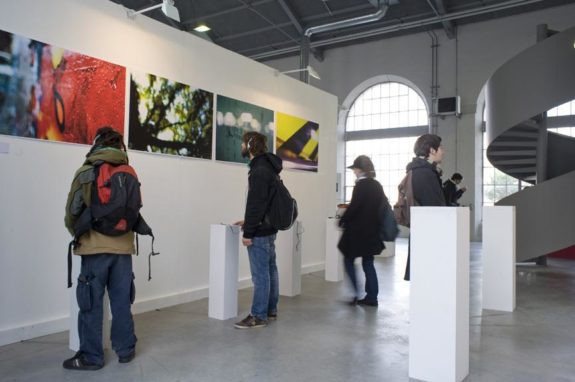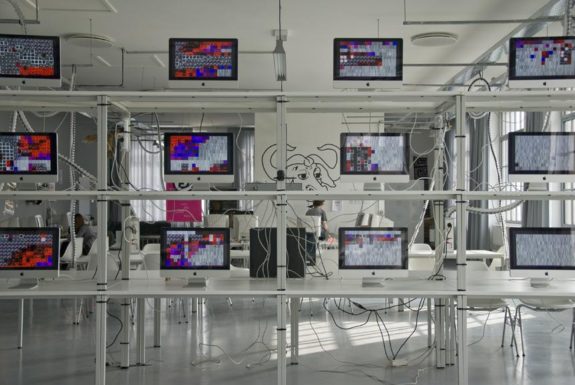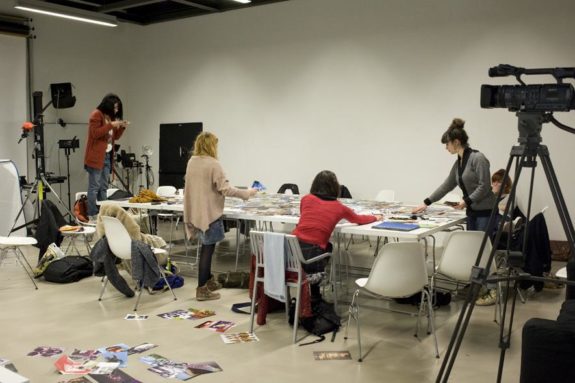The French Public Higher Schools of Art
Saint-Etienne
Ecole supérieure d’art et design de Saint-Etienne
about
The École supérieure d’art et design de Saint-Étienne and the Cité du design chose to settle on an ancient site of weapons manufacture, and have taken the form of a Public Institution for Cultural Cooperation (EPCC) since 2010. The training in the ESADSE takes place over 5 years. It is organized into two curricula with art and design options. The ESADSE also offers a Master’s 2 in Public Space, in partnership with the ENSASE and the UJM, a Design and Research postgraduate course and a Master Prospectives Design Advanced Design in partnership with the IAE Université Jean Monnet and the École des Mines of Saint-Étienne.
The association of the school with the Cité du design is a real advantage for the school, which benefits from the activities and network of the Cité du design: exhibitions, lectures, research programmes…With the Cité du design being in direct contact with the professional world, the ESADSE increases the opportunity for encounters and projects with different companies.
The ESADSE is also the only school of art and design in France to be completely involved in an internationally renowned event, the Saint-Étienne International Design Biennial. This event is a tool for training, exchange and visibility. It thus benefits from means with which to develop its networks through encounters, to valorize its production, to explore ambitious subjects and especially to work on the question of the exhibition and visual identity.







© Alexandra Caunes et Sandrine Binoux - École supérieure d’art et design de Saint-Étienne
École supérieure d’art et design de Saint-Étienne © Alexandra Caunes et Sandrine Binoux
Random LAB - École supérieure d’art et design de Saint-Étienne
Labo IRD © Alexandra Caunes et Sandrine Binoux - École supérieure d’art et design de Saint-Étienne
École supérieure d’art et design de Saint-Étienne © Alexandra Caunes et Sandrine Binoux
La tour observatoire © LIN Finn Geipel + Giulia Andi, photographe : Christian Richters - École supérieure d’art et design de Saint-Étienne
La Platine © LIN Finn Geipel + Giulia Andi, photographe : Christian Richters - École supérieure d’art et design de Saint-Étienne
options
Art
Design
Master Espace Public : design, architecture, pratiques
Master Prospectives Design
qualifications
DNA option Design
DNSEP option Art
DNSEP option Design
Master Prospectives Design
post-graduate
Post-diplôme Design & Recherche
Created in 1989, the Design and Research postgraduate course of the ESADSE is a place for experimentation, thinking and elaboration of projects based on a wide ranging and diversified vision of design. It operates simultaneously as a laboratory for creation, an incubator for projects and a research center. It is geared towards graduates of higher schools of art and design, to doctoral students and active designers. Among the tools at its disposal is the review Azimuts, an editorial asset designed and produced by student-researchers. The postgraduate programme is open to holders of a BAC +5 or professionals with at least 5 years of experience in the design field.
research units
IRD Le laboratoire Images – Récits – Documents (Laboratory for Images-Stories-Documents)
These three terms define the field of research within the Laboratoire
Images_Récits_Documents. The laboratory does not specify one single subject of research, its title communicates a desire to approach a field so as to consider its limits. The research operates on the exposition of logic between the three terms and does not pretend to exhaust the logic and issues contained in the image. The goal is for the IRD laboratory to measure and understand the modalities of the image in its current relationship with the real according to the determinations of the story as a field of production for the narrative staging of reality and according to its objective presentation (the document).
The IRD laboratory defines its general approach to research as theorized practice. The research questions the processes and procedures of the image: the field of research that is opened is that of imagenization. Practice is not the result of a preceding theory, it is thought of in terms of successive experiments allowing for the production of concepts. The object of the “image” is thus built within an approach wherein practice does not validate or overturn a hypothetical condition but where it is already a theoretical approach to the image that conditions the conditions of its appearance. The distribution-publishing is then a space of experimentation where the validity of concepts is determined.
The relationship with images currently concerns Art just as much as it does Design. The problematic axes deal with the sensitive visual and visible deployments and have the aim of understanding the place of images if the field of practices. Though the idea is to understand the redistribution of their production and uses, the idea is also to experiment with newer techniques of production of images and to understand how they are determined in, and through, the representation of an ideology. These questions then serve in the construction of unique and original images, integrating the transformation of the relationship of images to other practices of formulation and formalization of the world.
The IRD laboratory team: Kader Mokaddem, Jean-Claude Paillasson, Maurice Coussirat.
LEM The Laboratory for experimenting modernities
Since 1863, succeeding each other as methods of historical and theoretical reading of art have been modernity, the avant-gardes, modernism and postmodernity. But where are we now? Are we still modern? Have the avant-gardes really disappeared? Is modernism still appropriate? Are we all still soluble in all-in postmodernism? Or, has contemporary art defined a new mode that is unique to it? The Modernité(s) laboratory proposes to consider some of the questions being asked here, not for the simple pleasure of discussing the number of angels that can dance on the head of a pin, but to attempt to rethink our contemporaneity and that which is at stake for its main actors, those that we train: artists.
LEM team: Karim Ghaddab, Denis Laget and Éric Suchère
Associated researcher : Romain Mathieu
The RANDOM laboratory (lab)
The RANDOM (lab) of the Digital section of the ESADSE is a research space dedicated to experimentation in art, design and newer media. Set up in 2011, it proposes to follow a unique path between practice and theory.
In addition to being a resource center, and a work space allowing the creation of electronic installations, the RANDOM (lab) provides access to an “arduinothèque” made up of a selection of arduino systems and associable extensions. Students can in this way have a rapid and direct contact with this type of interface, so as to pass quickly from designing to modeling projects that incorporate electronics. Students associated with RANDOM (lab) also benefit from the range of software (3D, 2D, etc.) and materials (3D printer, digital printing…) available in the Digital section so as to best run the technical aspect of their projects.
Team: Damien Baïs, François Brument, David-Olivier Lartigaud.
publications
Exhibition catalogues
magazines
activities and events
Participation in the Saint-Étienne International Design Biennial
International exhibitions
Residencies for designers and artists
Programming of workshops, lectures and workshops during the Practice and Research weeks…
Internships and production in companies and institutions
“Le Garage” student association (sensitization to the world of free/open source in a wide sense)
international cooperation
International relationships with 65 partner schools, with 43 in Europe and 22 outside of Europe
Foreign promotion of young creators and internships abroad
gallery
La Platine (Cité du design)
specific equipment
Publishing section: press engraving, screen printing, lithography, lino engraving, offset, large format digital.
Video/ Sound section: digital capture unit, sound stage, digital and analog editing, sound studio.
Modeling section: forge, thermoforming, casting, locksmithing, mechanics, woodworking, cabinet making.
Photography section: film photography, digital photography, small, medium and large formats, studio, black and white film laboratories, large format digital printing.
Digital section: equipped with MAC and PC, 3D software, graphic solutions software, vectorial creation software, image treatment software, scanners, printers.
networks
ANdEA, ADÉRA, ELIA, Cumulus, Art Accord France, Consortium design enseignement supérieur (higher education), Kodec.
Participation in the Erasmus-Socrates LLP networks, Pépinières européennes for young artists.
administrative team
Yann Fabès Directeur
Valérie Delolme Responsable administratif
Caroline Engel Responsable des études
Justine Duchateau Responsable des relations extérieures
Béatrice Laffay Secrétariat de la scolarité
Hélène Pangot Secrétariat de la scolarité
Bernadette Côte Secrétariat de la scolarité
Josyane Franc Manager des relations internationales
Marie-Hélène Desestré Médiathèque
professors
Pierre-Olivier Arnaud
Damien Baïs
Emmanuelle Becquemin
Françoise Bernicot
François Brument
Denis Coueignoux
Rodolphe Dogniaux
Sophie Dupré
Karim Ghaddab
Cécile Giraud
Benjamin Graindorge
Laurent Grégori
Rémy Hysbergue
Éric Jourdan
Denis Laget
David-Olivier Lartigaud
Fabrice Lauterjung
Stéphane Le Mercier-Dauny
Vincent Lemarchands
Michel Lepetitdidier
Christophe Marx
Romain Mathieu
Kader Mokaddem
Marc Monjou
Jérémie Nuel
Valérie Orgeret
Jean-Claude Paillasson
Marie-Anne Pearce
Emilie Perotto
Philippe Roux
Yves Rozet
Anouk Schoellkopf
Éric Suchère
Samuel Vermeil
contact
3 rue Javelin Pagnon
42048 | Saint-Étienne Cedex 1
tél. +33 (0)4 77 47 88 00
fax +33 (0)4 77 47 88 01
infos@esadse.fr
www.esadse.fr
students
366 students and 9 students in Design and Research postgraduate course